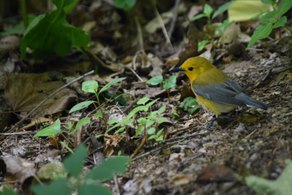Shared by Kim Bailey, Naturalist
kim.bailey@nashville.gov
Late May 2021
Have you noticed that bird chatter fills the air wherever you go these days? Not only are year-round resident birds such as cardinals and chickadees singing and nesting, but some recent migrants are too. Male songbirds who have spent the winter feeding in the tropics have been arriving throughout April and May to stake out their territory, which they claim by singing. This is why you see birders out en masse during the spring – there are a slew of newly-arrived bird species to see and hear!
Let’s meet a few of the birds that spend their winters in the tropics but their summers nesting in Tennessee:
The Northern Cardinal may rule the winter landscape with his brilliant red plumage, but in the summer, two other red birds vie for our attention. The male Scarlet Tanager is so striking, it graces the cover of Kenn Kaufmann’s Birds of North America. Its coal black wings against scarlet red plumage is breathtaking. It alerts us to its presence by its call note “Chick-burr”.
The stunning plumage of Scarlet Tanagers is a treat to behold.
The male Summer Tanager is a brighter red with no contrasting wings. Its frequent call of “pit-ti-tuck” is heard throughout the park in the summer.
Summer Tanagers are often heard in the park throughout the summer.
The female tanagers of both species are surprisingly different: the Scarlet female is a lemon yellow, the Summer a more orange-yellow.
Based on yellow plumage and time of year (summer), we determined this Summer Tanager is a female. She was banded at the Warner Park Nature Center Banding Station in 2009.
And to add to the confusion, the males spend their winters with yellow plumage, molting to the red plumage for breeding. That means you can find males mid-molt with a mix of yellow, orange and red feathers!
This Scarlet Tanager, in the process of molting to his breeding plumage, delighted our bird banding research team!
Several vireos nest here in summer as well. The incessant call of the red-eyed vireo can drive a birder a bit crazy at times. It repeats “Here I am, where are you?” over and over at a rapid pace while flitting from branch to branch looking for a juicy caterpillar to snag. Adults have the red eye that they are named for.
Its cousin the White-Eyed Vireo sings “Quick give me a rain check” and is easily recognized by the white eye. I often hear (but don’t see) the white-eyed vireos singing in dense shrubbery.
Adult White-Eyed Vireos have a distinctive white eye.
Male Indigo Buntings are a delight to see in spring when the feathers appear a vibrant blue. Have you ever noticed that in the shade the feathers appear drab but when the sunlight catches them they are a beautiful blue? Like other blue birds, their feathers don’t actually have blue pigment. It is the diffraction of light through the feathers that makes them appear blue. These beauties sing a series of whistled notes, often paired. I learned to listen for “Sweet sweet, spit, spit, chew chew” with a few extra notes at the end. The Hungry Hawk trail and Long Hollow are great places to search for these unique birds. Note the female and immature are a non-descript brown, sometimes with a few blue feathers intermingled.
Indigo Buntings prefer brushy pastures and woodland edges.
And now for my favorite group of birds, the warblers! To the beginner, these little birds are a confusing mix of yellow and green, with some black and white often thrown in as well. Learning their song is helpful, as is understanding their habitat preference.
The Common Yellowthroat heralds its presence with the distinctive song “whichity, whichity, whichity”. The male has a bright yellow throat and breast and a distinctive black mask across its face with a thick white border above. Listen for its call among the small trees and tall wildflowers in the Meadow Tree Trail at the Nature Center.
The Common Yellowthroat has a bright yellow throat and is found in fields searching for insects and spiders.
The Prairie warbler loves open scrub and cedar barrens. Its song is “zee zee zee zee zee zee zee” rising in pitch.
Prairie warblers have yellow throats and bellies with black streaking on the sides and a distinctive pattern on the face.
Prothonotary Warblers are the only cavity nesters among eastern warblers and they love to nest around the water. Their vibrant yellow head, neck and under-parts contrast with bluish-gray wings. I find these birds to be rather friendly and spy them most often from a kayak as they flit along the Harpeth River searching for food and tending their nests. I love their nickname, “Swamp Warbler”.
Prothonotary Warblers are unique in that they nest in cavities near water.
The Yellow Warbler can be found in a variety of habitats: forest edges and farmlands or grasslands with scattered trees. They are a solid yellow with a few rusty streaks on the breast. Their song sounds a bit like “sweet sweet sweet sweeter than sweet”, an apt description of how one feels when this bird is seen!
The Hooded Warbler is found in mature forests and can be a challenge to find as they sing high up in the trees. The male’s distinctive black hood surrounding a yellow face and lower body make it easily distinguishable if you find it in your binoculars. Their song “Towheet, toweet, towheeteo” is diagnostic as well.
It takes time to pick up bird songs and to associate habitats with certain birds, but with practice, the rewards are many. Here’s to finding some breeding migratory birds this summer!

















No comments:
Post a Comment